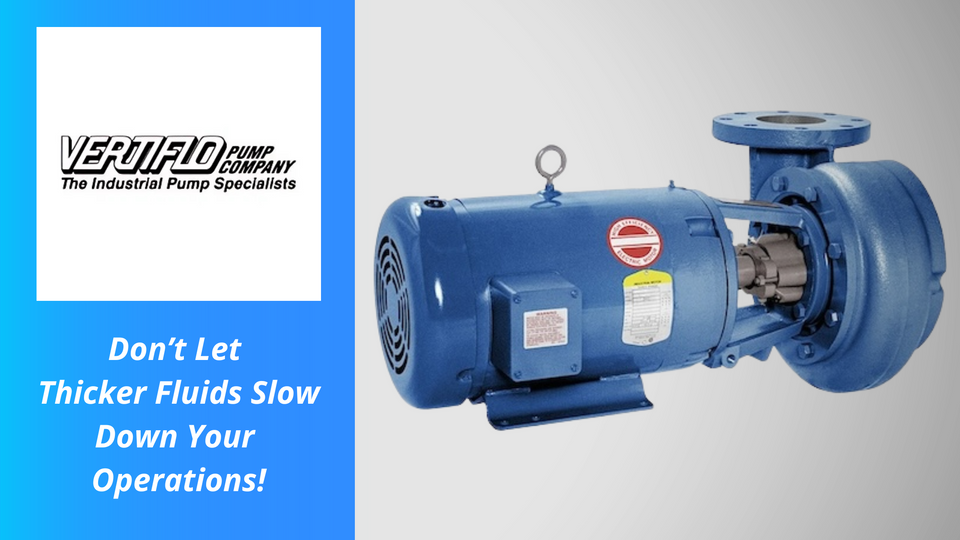When dealing with high-viscosity fluids like oils or syrups, using standard water-based pump performance curves won't give you accurate results. To ensure your Vertiflo centrifugal pump operates efficiently, you'll need to make essential adjustments that account for the fluid’s higher resistance to flow.
Below, we’ll walk through why viscosity matters, the importance of adjusting pump performance curves, and practical tips for applying viscosity corrections to keep your Vertiflo pumps running smoothly.
Why Viscosity Matters
Viscosity is essentially how thick or resistant a fluid is to flow. Think of the difference between water and syrup: water flows easily, while syrup moves much slower. This property of viscosity affects how well a pump performs, and if you're pumping thicker fluids, the standard water-based performance data won’t cut it.
Higher viscosity fluids decrease volumetric flow rate, head (the height fluid can be pumped), and efficiency, while increasing power demands and Net Positive Suction Head Required (NPSHr). These factors mean your pump has to work harder and less efficiently when handling more viscous fluids unless adjustments are made.
The Importance of Pump Performance Curves
Pump performance curves help visualize how a pump will behave across different conditions—like varying flow rates and power demands. They’re a critical tool for engineers. However, these curves are typically based on water as the working fluid, which leads to inaccurate results for thicker fluids.
This is where ANSI/HI 9.6.7-2015 guidelines come into play. These guidelines offer a standardized method for adjusting performance curves when working with fluids that have different properties from water. While these guidelines come with some uncertainties, they are a reliable starting point for making viscosity corrections to your Vertiflo pump’s performance data.
Understanding Viscosity Corrections
The ANSI/HI 9.6.7-2015 guidelines adjust the volumetric flow rate, head, and efficiency of your pump using empirical corrections. While this process isn’t perfect—there are uncertainties related to the complexity of fluid behavior, data limitations, and measurement accuracy—it provides a useful framework.
At the heart of this correction process is the Reynolds number, which helps estimate frictional losses due to increased viscosity. Essentially, the thicker the fluid, the more friction is created, leading to reduced pump efficiency.
Applying Viscosity Corrections
To adjust your Vertiflo pump’s performance, engineers use a dimensionless number called B. This number factors in both the Reynolds number and the specific speed of the pump, helping to estimate the necessary corrections for flow rate, head, and efficiency.
One important assumption in this method is that the flow and head correction factors are equal at the best efficiency point (BEP) when using water. When tested with actual data, most pumps—including Vertiflo models—perform within an acceptable range, even when handling viscous fluids.
Practical Application and Considerations
In most real-world cases, the ANSI/HI viscosity corrections will offer reliable predictions of your Vertiflo pump’s performance when handling thicker fluids. However, for added safety, engineers can adopt a more conservative approach by slightly lowering the correction factors. This ensures the pump is adequately sized and prevents underperformance in challenging conditions.
Keep in mind that these corrections are most accurate for systems that fall within a typical range of viscosity, specific speed, and impeller size. If your system operates outside these parameters, you may need to make additional adjustments or seek more precise performance data.
Conclusion
Adapting your Vertiflo pumps for high-viscosity fluids is essential to ensure optimal performance and efficiency. By applying the ANSI/HI 9.6.7-2015 guidelines and understanding the key factors that impact pump behavior with thicker fluids, you can make informed decisions to maintain reliability in your system.
With these corrections, your Vertiflo pumps can handle the challenges of viscous fluids, reducing the risk of performance issues and keeping your operations running smoothly. Check out Vertiflo products here.

